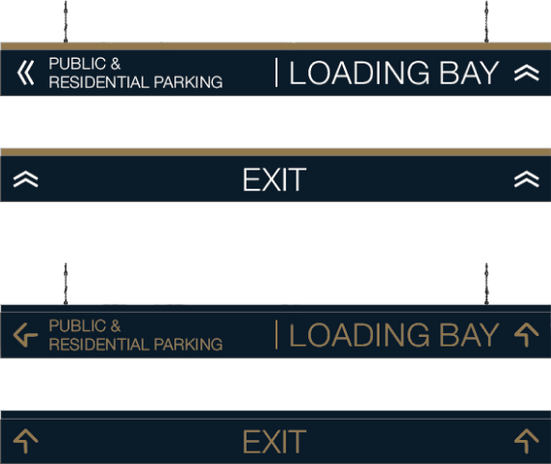Landmark on Robson
Luxury wayfinding, intuitive navigation, and a seamless visitor experience
EXPERIENTIAL DESIGNER | WAYFINDING, SPATIAL EXPERIENCE, SIGNAGE INTEGRATION

Landmark on Robson, a premier mixed-use development, required a user-centered wayfinding system to enhance navigation throughout its multi-level parkade and retail spaces. The existing signage lacked clarity, consistency, and intuitive placement, leading to confusion and frustration for visitors. Without a clear hierarchy of information, users struggled to locate parking levels, exits, and retail destinations, making the experience feel disconnected from the high-end brand identity of the space.
The project focused on designing a system that improved legibility, spatial awareness, and decision-making, ensuring visitors could navigate instinctively while maintaining a visually cohesive brand experience. The goal was to provide a seamless experience from arrival to departure, reducing the need for second-guessing or backtracking.
My Role
As Lead Designer, I was responsible for shaping the wayfinding strategy to enhance user experience while maintaining a strong brand presence. My process included conducting site assessments and user flow analysis to identify navigation pain points and ensure signage placement optimized user movement.
Collaborating closely with the client, I defined user experience goals and brand alignment requirements, ensuring all design decisions adhered to architectural and municipal guidelines. My role involved developing signage guidelines, refining visual hierarchy, and balancing aesthetics with functionality, creating an intuitive navigation system that improved both efficiency and brand perception.
Challenge
Navigating a multi-use development of this scale presented several challenges. The existing signage did not support predictable user flow, forcing visitors to pause, backtrack, or rely on trial and error to find their way. Parkade users faced difficulty identifying levels, exits, and directional cues, leading to congestion and inefficiencies. In the retail spaces, inconsistent branding and a lack of clear signage made it harder for customers to locate stores and amenities.
The key challenge was to design a system that provided clear, intuitive navigation without overwhelming visitors with excessive or redundant information. The solution needed to be both functional and visually refined, reinforcing Landmark on Robson’s upscale positioning while improving wayfinding efficiency.
Outcome
A comprehensive signage system was implemented to enhance navigation throughout the development. Parkade signage was redesigned with clear level indicators, directional markers, and high-visibility exit signage, reducing cognitive load for drivers and improving traffic flow. Retail wayfinding was standardized, ensuring signage remained cohesive while allowing flexibility for individual tenants.
The final design prioritized legibility, contrast, and strategic placement, making it easier for visitors to locate key destinations without hesitation. Usability testing confirmed that the updated system significantly improved navigation speed and overall visitor confidence, reinforcing the development’s reputation as a premium destination.
Execution
A detailed site analysis and user journey assessment identified problem areas where signage updates were most needed. Through walkthroughs, architectural plan reviews, and competitive research, best practices in wayfinding, contrast ratios, and typography were evaluated to inform design decisions. Findings revealed that existing signage lacked hierarchy and clarity, making it difficult for visitors to process information quickly.
The redesigned system focused on simplifying decision points, reinforcing directional cues, and maintaining visual consistency across different areas of the development. Usability testing with sample visitors confirmed that the updates reduced navigation errors and improved wayfinding efficiency, ensuring visitors could locate destinations with minimal effort.
Impact
The updated wayfinding system significantly improved visitor navigation and overall user confidence. Parkade enhancements streamlined traffic movement, reducing time spent searching for exits and parking spots. In retail areas, a refined signage strategy strengthened brand cohesion while improving visibility of key destinations. Visitors reported that navigation felt more intuitive and effortless, reinforcing the premium experience expected at Landmark on Robson.
Reflection + Key Takeaways
Effective wayfinding is an extension of user experience design, influencing how visitors interact with and perceive a space. This project reinforced the importance of reducing cognitive load, ensuring that decision points feel natural and effortless. By prioritizing hierarchy, visibility, and consistency, the signage system successfully balanced functionality and aesthetics, making navigation not just easier but also more aligned with the development’s luxury brand identity.
The experience also highlighted the impact of usability testing in environmental design, confirming that thoughtful placement and design decisions directly influence navigation efficiency and visitor satisfaction.




